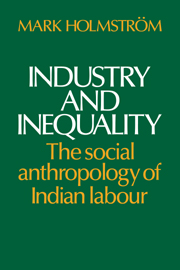2 - Industrial labour in India
Published online by Cambridge University Press: 05 February 2012
Summary
The ‘dual economy’ – or at least the sharp division of the work force into those employed in the organized and unorganized sectors – is fairly new, dating from the great expansion of Indian manufacturing industry since Independence and especially since 1960. But this ‘dualism’ has its roots in the older pre-industrial society, and in the history of the ‘industrial’ work force since its nineteenth-century beginnings.
This chapter gives a critical survey of some historical studies of the industrial work force and of industrial towns, especially but not only as these studies point to the later emergence of the unorganized sector as a distinct part of manufacturing industry, and a separate class of ‘unorganized’ casual or temporary workers in organized sector firms. These changes were the result of several things: increasingly complex technology, requiring an educated work force with special skills; labour legislation; union pressures; and organized sector workers' changing assumptions about work, about the career as a line leading somewhere rather than a random succession of jobs, and about social status and the dignity of labour.
Reading the historical material, we should go beyond the common idea that ‘western’ technology necessarily involves the import of a whole package of institutions and attitudes – the package labelled ‘westernization’. But still this technology was brought to India with at least some of the forms of organization, and assumptions about work and industrial relations, which were then current in the west, particularly in Britain; and with a form of western free market capitalism, distorted in the special conditions of colonial rule.
- Type
- Chapter
- Information
- Industry and InequalityThe Social Anthropology of Indian Labour, pp. 26 - 75Publisher: Cambridge University PressPrint publication year: 1984

